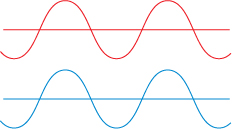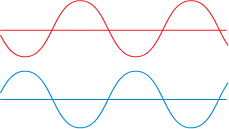Module 8—Mechanical Waves
 Lesson Summary
Lesson Summary
As you worked through this lesson, you should have developed answers to the following questions:
- How can waves be described using phase and phase angle?
- What is constructive and destructive wave interference?
- What is wave superposition?
- What is a standing wave? How is this related to musical tones?
Since a transverse wave is a sine curve, a phase angle can be used to describe the relative position of the waveform along a horizontal axis on which it is moving. In other words, wave movement can be measured by a change in phase angle.
Constructive interference occurs when two waves or pulses are in phase (crest to crest or trough to trough), creating a waveform with a greater amplitude. Destructive interference occurs when two waves or pulses are out of phase (crest to trough), creating a waveform with smaller amplitude—zero in the case of complete destructive interference.
The principle of superposition states that the displacement of the combined waveform or pulse at each point of interference is equal to the sum of the displacements of the individual waveforms or pulses.
A standing wave is a condition in a medium where a wave seems to oscillate around stationary points called nodes. This occurs at specific frequencies particular to the medium and in musical instruments that produce specific tones you can hear.
Lesson Glossary
antinode: a place on a standing wave with maximal amplitude
constructive wave interference: overlapping of waves so the crests match with crests and troughs match with troughs

destructive wave interference: overlapping of waves so crests match with troughs

node: a place on a standing wave with minimal amplitude
phase shift: for two sine waves, the change in angle needed to change the first sine wave into the second
resonant frequency: the frequency at which an object naturally vibrates
standing wave: a wave that appears not to be travelling (stays in a constant position)